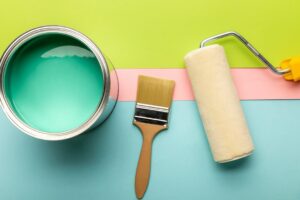To begin,
Painting a room or piece of furniture can seem like a straightforward task, but even seasoned DIY enthusiasts can encounter issues that impact the final result.
Understanding common painting mistakes—and knowing how to fix them—can save time, money, and frustration. This guide explores frequent painting errors, how to avoid them, and practical solutions if they occur.
1. Skipping Surface Preparation
The Problem:
One of the most common mistakes is neglecting proper surface preparation. Painting over dirt, grease, or loose paint can lead to uneven application, poor adhesion, and peeling.
The Fix:
- Clean surfaces with a mild detergent or degreaser.
- Sand rough or glossy areas to create a smooth surface.
- Patch holes or cracks with filler and sand them down for an even finish.
- Prime bare surfaces or areas with high stains to ensure even color and texture.
2. Using the Wrong Tools
The Problem:
Low-quality brushes, rollers, or paint sprayers can leave streaks, uneven coverage, and visible bristle marks.
The Fix:
- Invest in high-quality brushes and rollers designed for your paint type (e.g., synthetic for latex paints, natural for oil-based).
- Choose the right nap roller for your surface—short nap for smooth surfaces, longer nap for textured ones.
- Clean and maintain your tools properly for reuse.
3. Overloading or Underloading the Brush/Roller
The Problem:
Overloading the brush can lead to drips and runs, while underloading can result in streaky or patchy coverage.
The Fix:
- Dip the brush one-third of the way into the paint to avoid excess.
- Roll your roller on the tray’s ridges to evenly distribute paint.
- Apply paint in thin, even layers rather than trying to cover in one coat.
4. Choosing the Wrong Paint
The Problem:
Selecting the incorrect type of paint for the surface or environment can lead to premature wear, peeling, or fading.
The Fix:
- For high-traffic areas or kitchens, use washable and durable paints like satin or semi-gloss.
- For ceilings, use flat or matte paint to hide imperfections.
- Use exterior-grade paint for outdoor projects to withstand weather and UV exposure.
5. Ignoring Drying Times
The Problem:
Applying a second coat too soon can cause streaking, peeling, or uneven finishes.
The Fix:
- Follow the manufacturer’s recommended drying times between coats.
- Ensure proper ventilation or use a fan to aid drying in humid environments.
6. Painting in Poor Conditions
The Problem:
Painting in extreme temperatures, high humidity, or direct sunlight can cause issues like blistering, cracking, or uneven drying.
The Fix:
- Paint when temperatures are between 10–30°C (50–86°F) and humidity levels are low.
- Avoid painting in direct sunlight to prevent rapid drying.
7. Leaving Painter’s Tape Too Long
The Problem:
Removing painter’s tape too late can cause it to tear the paint, leaving uneven edges.
The Fix:
- Remove painter’s tape while the paint is still tacky but not wet.
- Pull the tape at a 45-degree angle for a clean line.
8. Not Using a Primer
The Problem:
Skipping primer can lead to uneven color, poor adhesion, and issues like stains bleeding through the paint.
The Fix:
- Use primer on new surfaces, dark walls, or areas with stains.
- For surfaces like metal or plastic, use a primer formulated for the material.
9. Drips and Runs
The Problem:
Excess paint can create unsightly drips and runs, especially on vertical surfaces.
The Fix:
- Wipe away excess paint immediately with a damp cloth.
- Sand dried drips lightly and repaint the area.
- Use smaller amounts of paint on brushes and rollers to avoid overloading.
10. Uneven Coverage or Patchy Results
The Problem:
Applying paint unevenly can leave visible roller or brush marks.
The Fix:
- Apply a consistent amount of pressure when using a roller or brush.
- Work in sections, maintaining a wet edge to avoid overlap marks.
- Use two coats of paint for uniform coverage.
11. Failing to Stir Paint Properly
The Problem:
Unmixed paint can lead to inconsistent colors or texture.
The Fix:
- Stir paint thoroughly before use, even if it’s freshly purchased.
- Use a paint mixer attached to a drill for large quantities.
12. Improper Cleanup
The Problem:
Leaving brushes or rollers uncleaned can render them unusable for future projects.
The Fix:
- Clean brushes and rollers with water for water-based paints or mineral spirits for oil-based paints immediately after use.
- Store tools in a dry, clean place to prevent damage.
13. Ignoring Safety Precautions
The Problem:
Exposure to fumes, spills, and improper handling of tools can pose health and safety risks.
The Fix:
- Ensure adequate ventilation while painting.
- Wear protective gear like gloves, masks, and safety goggles.
- Use drop cloths to protect floors and furniture from spills.
14. Forgetting About Sheen Variations
The Problem:
Using the wrong sheen inappropriately can highlight flaws or result in excessive glare.
The Fix:
- Use flat or matte finishes to hide imperfections.
- Apply satin or semi-gloss for areas requiring easy cleaning, like bathrooms and kitchens.
- Consistently use the same sheen throughout a single surface.
15. Poor Storage of Paint
The Problem:
Improper storage of leftover paint can render it unusable for touch-ups.
The Fix:
- Store paint in a cool, dry place with the lid tightly sealed.
- Label cans with the room or area they were used in for easy identification.
Conclusion
Painting is an art that requires preparation, the right tools, and proper technique. Avoiding common mistakes can save you time, effort, and money while delivering a professional-quality finish. If you do encounter a problem, remember that most mistakes can be corrected with a bit of patience and know-how.
With this guide, you’re now equipped to tackle your next painting project with confidence and achieve flawless results. Better still, contact Plusworld Coatings for that perfect finish!





